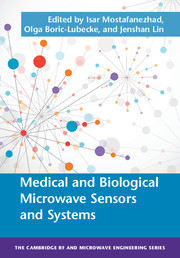Book contents
- Frontmatter
- Contents
- Contributors
- 1 Implantable Wireless Medical Devices for Gastroesophageal Applications
- 2 Embedded Wireless Device for Intracranial Pressure Monitoring
- 3 Wireless Intracranial Pressure Systems for the Assessment of Traumatic Brain Injury
- 4 Microwave Biosensors for Noninvasive Molecular and Cellular Investigations
- 5 Wearable Radar Tag Systems for Physiological Sensing/Monitoring
- 6 Physiological Radar Sensor Chip Development
- 7 Noise- and Interference-Reduction Methods for Microwave Doppler Radar Vital Signs Monitors
- 8 Biomedical Applications of UWB Technology
- Index
- References
7 - Noise- and Interference-Reduction Methods for Microwave Doppler Radar Vital Signs Monitors
- Frontmatter
- Contents
- Contributors
- 1 Implantable Wireless Medical Devices for Gastroesophageal Applications
- 2 Embedded Wireless Device for Intracranial Pressure Monitoring
- 3 Wireless Intracranial Pressure Systems for the Assessment of Traumatic Brain Injury
- 4 Microwave Biosensors for Noninvasive Molecular and Cellular Investigations
- 5 Wearable Radar Tag Systems for Physiological Sensing/Monitoring
- 6 Physiological Radar Sensor Chip Development
- 7 Noise- and Interference-Reduction Methods for Microwave Doppler Radar Vital Signs Monitors
- 8 Biomedical Applications of UWB Technology
- Index
- References
Summary
Introduction
Doppler radar has recently been extensively used in noncontact cardiopulmonary monitoring [1–3]. A continuous wave (CW) microwave signal is transmitted toward a human subject. Physical motion caused by the respiration and heartbeat of the human subject phase modulates the transmitted signal and reflects it back to the transmit antenna, where it is received and phase demodulated to yield the heart and respiration rates of the subject. Physical motion of the human chest during respiration and heart motion are measured to be about 0.2 to 2 and 8 to 20 mm, respectively [4]. Thus the system has to be very sensitive to phase changes, which are caused by path-length variations. For a stationary transmitter and subject, this path length only varies with a subject's heartbeat and respiration. A nonstationary transceiver antenna or a fidgeting subject will produce additional path variations causing interference in radar signal (Figure 7.1).
There are cases where the transmit/receive antenna cannot be assumed to be physically stationary. For example, if the transceiver is a handheld unit used in search and rescue operations or to sense through walls in military applications, “hand shake” of the operator will introduce path-length variations that phase modulate the received signal in addition to that of the target's cardiopulmonary motion. Also, if the antenna is placed on a platform subject to some vibration, the vibration can cause antenna motion, creating an interference with the radar signal. Monitoring a driver in a vehicle is an example of such an application. Thus the final demodulated signal will include components resulting from operator's unwanted hand shake to the extent that life signs monitoring will become impossible due to excessive interference. The fidgeting of the subject, which can be the result of coughing, sneezing, itching, and similar activities, is another source of this type of interference.
While most sources of unwanted interference motion are random, they can still be categorized to a certain extent by their frequency spectrum and amplitude. For example, a 2003 Ford Taurus with a V6 engine being driven on a flat freeway at a speed of 65 mph creates about 3 to 9 mm of shake at a low frequency of 1.2 Hz [5].
The problem of undesired instrument shake is similar in still image and video cameras, where it causes motion blur in the captured image.
- Type
- Chapter
- Information
- Medical and Biological Microwave Sensors and Systems , pp. 202 - 227Publisher: Cambridge University PressPrint publication year: 2017



